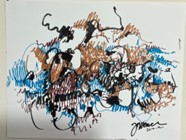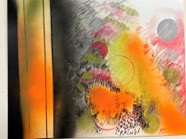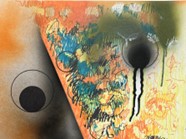 This month’s Oculus column presents new drawings by Judith Kaufman Weiner, and the raison d’etre that guides the artist’s hand in a series she calls “From the Particular to the Universal.” The artist is a founding member of the shul’s Judaism and Art group.
This month’s Oculus column presents new drawings by Judith Kaufman Weiner, and the raison d’etre that guides the artist’s hand in a series she calls “From the Particular to the Universal.” The artist is a founding member of the shul’s Judaism and Art group.
“Drawings are often a window into the thinking process of an artist,” Judith Weiner said. “It can be the space for new discoveries, new ideas and, perhaps, unfettered adventure. Within a drawing lies a spontaneous response to new ideas and new discoveries, but also the solution to unresolved problems. Sometimes pictorial problems will surface within a new drawing, yet they may take on new forms that have been influenced by interim drawing and painting experiences.
“My work tends to develop as a series, a continuum. I find that more images and ideas emerge in the mark-making process than can be contained within a single ‘picture.’ In this way, the series becomes a long work — one that can be subdivided, each part offering a clear relationship to its predecessor as well as to its successor. But those relationships may or may not matter, because each image can and should stand alone. Each ‘picture’ becomes a component of the exploration that is contained within the edges of the paper or canvas or the three-dimensional construct. But there are contradictions. Sometimes the influence of a drawing or painting extends beyond its own physical boundaries.
“The group of drawings you see here represents nuanced spaces that move from the particular to the universal. All the formal elements are there: color, shape, balance, depth, composition and scale. Each work is a process of discovery, one building upon the other, moving into a new space or drawing to continue the adventure.
“You see the elements that describe and define light, space, speed and spatial tensions. The abstract images represent perceptions of the human drama and a response to an ever-evolving and unfolding environment. Several of these drawings conform to a geometric structure that is the holding grid for the markings articulated there. I employ this concept frequently with varying outcomes.
“So there you have it — a bit of discourse that speaks to the images shown here, as well as insight into my own working process.”
—Judith Kaufman Weiner



Get Social